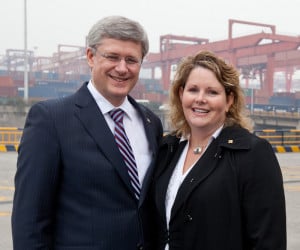 Gray and former Prime Minister Stephen Harper in China as first containers are received from CentrePort.
Gray and former Prime Minister Stephen Harper in China as first containers are received from CentrePort.As Canada’s first tri-modal inland port and Foreign Trade Zone, CentrePort offers direct access to national and international rail, truck and air cargo operations.
More than just a trade centre, CentrePort expects to bring major change to the Winnipeg landscape, driving economic growth and adding value to the community.
We sat down with CentrePort President and CEO, Diane Gray, to learn more about North America’s largest inland port and the impact it could have on the local community and North America’s transportation industry. As a transportation leader, Bison Transport is heavily invested in the development of our industry and we are excited to partner with CentrePort as we continue to drive our economy.
This is the second installment in our four-part series:
Growing CentrePort’s Business
With support very high for CentrePort, Gray and her team are focused on accelerating growth as they continue to add to the 43 tenants they already have on the property.
The port has been working with real estate companies and other economic development agencies to identify companies who may be interested in coming to CentrePort and the result is a business plan that lists 71 prospects targeted over the next five years.
 Brian Hazzard, Sr. VP of Domestic Ops for BroadGrain Commodities, Manitoba Premier Greg Selinger, Gray and Bison CEO Don Streuber announce BroadGrain as the anchor tenant of CentrePort's rail park.
Brian Hazzard, Sr. VP of Domestic Ops for BroadGrain Commodities, Manitoba Premier Greg Selinger, Gray and Bison CEO Don Streuber announce BroadGrain as the anchor tenant of CentrePort's rail park.These targets each fit one of six sectors that CentrePort has been gathering quantifiable information on: Advanced Manufacturing, Agribusiness & Food Processing, Biomedical, E-Commerce, Energy & Mining and Transportation & Logistics.
As CentrePort works to make inroads in each of these target sectors, the goal is to develop strong relationships with partners and current clients, who will spread the word about the port’s value.
“Our goal is to have lots of ‘Small A ambassadors’ for CentrePort,” Gray said. “We want people saying this is great, there is great infrastructure and access to multiple modes of transportation on the footprint.”
CentrePort’s Economic Impact
As a major trade centre, CentrePort aims to create economic growth locally and beyond Manitoba’s borders.
In attracting 43 greenfield companies to the site, the port has already created hundreds of new jobs and expects that number to continue to grow quickly. With a water treatment facility on the verge of completion, waste water infrastructure set to be complete in early 2016 and CentrePort Canada Way, the four-lane, 212-million dollar highway that connects CentrePort to the perimeter, in the process of being doubled, the property has created a platform for companies to locate and build their business.
The project is expected to generate a significant increase in tax revenue for local government as well, which means stronger support for social programs and a stronger economic environment. But Gray and her team believe CentrePort has the ability to make a significant impact beyond the local community as well.
“Our reach extends beyond Winnipeg’s borders,” Gray said. “Companies that locate in Manitoba are more likely than anywhere else in Canada to trade more domestically than they are internationally. That means trade corridors, into other provinces and the United States, are an important part of what we think about.”
A combination of policies, trade incentives and CentrePort’s status as a Foreign Trade Zone (FTZ) allows companies at the port to engage in international activities and import from foreign markets without free trade agreements, where trade might typically be more difficult.
Click here to read the CentrePort (Part I): The Birth and The Future.
Watch for CentrePort (Part III): Sustainability and The Community later this week.